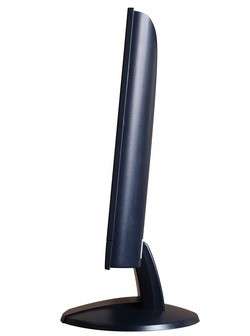How to choose a monitor for a computer – we will consider in detail all the parameters
It is a fairly common occurrence when an inexperienced buyer, when purchasing office equipment for the home, absolutely does not think about how to choose a monitor for a computer. It is clear that when choosing the configuration of the system unit, many still use the recommendations of good friends, written down on a piece of paper. At the same time, it is remembered about the amount of RAM, about the frequency and number of processor cores, about the size of the hard disk, about the capabilities of the video card, etc. Others pay even more attention to choosing a “mouse" or keyboard from their huge variety, but monitors are a problem. You can often hear: “cheaper”, “beautiful”, “bigger”, “on a beautiful leg”, etc., at best, they will call the size diagonally.
This is a very serious mistake. Despite the apparent similarity at first glance, the monitors differ significantly both in their parameters and in their functional purpose. What’s the point of carefully completing a "system unit" if an incorrectly selected monitor will not allow the computer to "fully open up"?
In order to make an unmistakable choice, it is necessary, firstly, to clearly imagine what the computer will be mainly used for. Secondly, it would be nice to arm yourself with basic knowledge about the parameters of monitors and their fundamental differences. And thirdly, decide on the amount that will be planned for its acquisition. After comparing all these components, the problem of how to choose a good monitor for a computer will acquire options for its solution.
Screen size – bigger is better?
Everyone probably knows about this option. It is calculated in inches (most often you can find the designation "", inch or in). If anyone doesn’t know, 1" = 2.54 cm. Nowadays, you probably won’t find a screen smaller than 19 inches. They belong to the category of the most budgetary and are quite suitable for working with documents or visiting Internet sites. However, even at 22 inches now the price is not too “biting”. For monitors 24in and more, of course, you will have to pay more.
A special topic is screen proportions. Probably, such a familiar ratio as 4 x 3 is forever becoming a thing of the past. The market has been conquered by 16 x 10 monitors, widescreen, reminiscent of a screen in movie theaters. By the way, watching them "cine" video – a pleasure. And in the work, the inconvenience that seems at first will quickly be replaced by the habit of such a screen, which, according to many, is much more functional, especially when working with graphics or when building rulers in video editing applications.
Screen resolution
With this value, some do not have clarity, although this parameter does not contain anything complicated. Resolution is the number of pixels (light dots) on the screen. Probably, it is not necessary to explain that the larger this parameter, the clearer the image will be.
Almost all monitors have the ability to change the resolution, but here you should pay attention to one point. Increasing the resolution often leads to a decrease in the screen refresh rate, and if this parameter is below 60 Hz, working with a computer will be fraught with fatigue and possible headaches. Thus, it is necessary to consider the real possible resolution from those positions so that the screen refresh rate is still not lower than 60-75 Hz (or better, higher).
If the conversation turned to pixels, two more nuances can be noted. First, its size should be no more than 0.3 mm, and ideally 0.273. And secondly, you should definitely check with the sales assistant about the rules in force in their store for checking monitors for “broken” pixels, which will be visible on the screen as unchanging black or white dots. Most manufacturers consider it acceptable to have 3 – 4 "broken" pixels, not classifying such products as substandard, but it’s better to try to get a completely "healthy" monitor.
Matrix type
The quality of the image, its dynamism, color accuracy, saturation, contrast and many more parameters familiar to specialists depend on this parameter. When deciding on a question, for example, how to choose a monitor for a computer for games, this must be taken into account without fail.

You should not succumb to the persuasion of children demanding to buy something "cooler". There is a risk of purchasing an expensive monitor with IPS – a matrix, which is intended, rather, for professional photographers and designers, but you can’t get a dynamic picture on it – even when watching movies, the image may be slightly “blurred”. The same can be said about the PVA / MVA matrix, although it should be taken into account when deciding how to choose a monitor for a computer – the video on it will look very decent (response time is within 25 ms).
Viewing angle
For LCD monitors, this is a very important parameter. Of course, if a single workplace is supposed to be, you can not pay special attention to this. But in a situation where you want to watch a movie with the whole family, or remember old photo albums, this feature will be very important here. To avoid inconvenience, it is better to opt for models that provide optimal viewing in a sector of at least 160 degrees.
Brightness, saturation, color depth
Currently, monitors and video cards with a color quality of 24, 16 or less bits, perhaps, cannot be found, and the existing 32 bits should fully satisfy everyone.
Contrast shows the ratio of the glow of the brightest and darkest points, and is expressed in fractional form, for example, 3000: 1. The optimal contrast value that you should focus on when choosing is about 1000: 1. You can see "super offers" with values of both 5 and 10 thousand, but, as experts say, this is more – a marketing trick to inflate prices – human vision is unlikely to notice the difference.
Brightness is the amount of light output from a completely white monitor, and its normal value is in the range of 250 – 400 cd/m2. meter (should be indicated in the product passport).
Availability of a DV port
If your computer video card has a DV (digital) connector, then you should look for a monitor with the same one. Reliable, but slowly being phased out, VGA (analog) cables don’t provide the picture quality that the "numbers" are capable of. The fact is that the video signal does not have to undergo double conversion during transmission (digital – analog – digital), it passes directly, which significantly improves the quality of the resulting picture.
Case, mount, controls
Here, of course, there is scope for personal preferences in the design of your computer corner. Case colors are mostly black or silver-steel, but you can sometimes find more "creative" colors. The main thing is that bright colors do not interfere with the normal perception of the image from the screen. The same can be said about the matte or glossy screen – more comfort in the first case, brighter colors in the second.
Any monitor has several buttons to exit, if necessary, the setup menu and make the necessary adjustments. Their execution and location on the case can be different, you won’t give advice on choosing here – someone likes “mechanics” more, someone prefers sensors. The use of buttons, as a rule, is described in detail in the "manual".

If the buyer liked the monitor, which has an external power supply – this is only welcome. Such products have smaller dimensions, they do not heat up as much, and in the event of a power supply failure (a fairly common failure), it can be replaced with another one, or repaired without opening the monitor case.
Which brand to choose?
The world’s leading manufacturers are always competing with each other, trying to beat rivals in terms of the quality characteristics of their products. How to choose a monitor for a computer, which company to prefer? The reader will not receive an unequivocal answer – when buying, it is necessary to take into account all the factors described in the article, and only then make a choice based on the price-quality principle. A reasonable decision would be to get acquainted with the list of representative offices and service centers of well-known companies – no one is ever insured against breakdowns. Perhaps the presence of such a branch nearby will decide the issue of choice. When sending equipment for warranty service, it takes not so much time to repair as the process of its delivery back and forth.
The word "brand" refers specifically to well-known companies. Buying ordinary fakes or "works" of mysterious companies with hard-to-read names, in most cases – money down the drain. You should not buy such dubious monitors, no matter how inexpensive they are, no matter how the sellers persuade.
Do you want "twists"? Is it worth it?
You can often find monitors on which additional options are “hung”. The most common – sound speakers, you can find a built-in TV tuner. Of course, the matter is good, but, from the point of view of expediency and price, perhaps not entirely justified. If the built-in elements fail, then the entire monitor will have to be carried for repair – probably, this is not very convenient. Expecting good sound from the internal speakers is naive. The tuner, if necessary, is easily integrated into the system unit.
So, having clearly defined the functional purpose of the computer for yourself, writing down all the desired requirements for the monitor on a piece of paper and taking the necessary amount of money, you can go to a serious showroom for a purchase.
